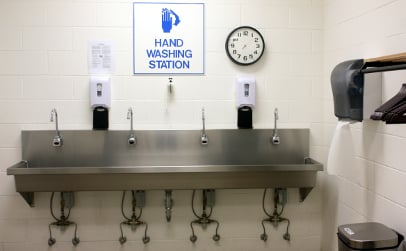We unconsciously touch our face with our hands multiple times a day, not realizing we could potentially introduce germs into our eyes and mouth. And with this happens, the germs could make us sick. It’s been scientifically proven that the simple act of hand washing with soap helps remove germs from the hands, preventing the spread of viruses and illness.
However, we need proper hand washing equipment to wash our hands effectively. Therefore, beyond promoting hand washing habits, worksites should also provide employees with clean and maintained hand wash stations. Regularly maintaining sinks helps prolong their lifespan and helps prevent costly repairs if it becomes damaged.
A hand wash station that needs repair will need to be put out of service, impacting the workers’ ability to maintain regular hand washing habits. Therefore, understanding how to maintain the sink’s parts and functions can make a difference in increasing the wash station’s longevity and maintaining the workforce’s productivity and adherence to proper hand hygiene.
Hand Wash Station Inspection and Maintenance Best Practices
Maintain the main parts of the hand wash station - To ensure hand wash stations are working optimally, focus on ensuring that its parts are functional. The main components of a hand wash station are the following:
- Hoses – Sinks have different hoses for transporting water to the tank and the basin. Hoses should be kept clean to prevent build-up and ensure clean water flow. Typically, a cleaning solution of 10% household bleach and water should be enough. Also, inspect the hose for damage, which can reduce water flow.
- Tank – Mold, sediment, and even algae can build up in the lining of tanks; therefore, tanks should be checked regularly. When they are full, the wastewater should be emptied. You should also check the tank for signs of wear and tear, such as cracks.
- Basin – The basin should be rinsed with every use because even soap can create a grimy buildup. Pay attention to the faucets and sink hardware where dirt may accumulate.
Keep cleaning products and equipment handy – The person assigned to maintain the hand washing station should have access to cleaning products and equipment, such as brushes, disinfectant, chlorine, bleach, and pumping wands.
Follow an inspection schedule – Regular maintenance of hand washing stations should follow a daily, weekly, and monthly plan.- Daily – To prevent build-up, the basin, faucet, and counter should be rinsed and wiped down with a non-abrasive cleanser daily. Remove any debris that may have accumulated in the strainers. It’s also important to dry all surfaces.
- Weekly – Tanks, aerators, tank connectors, and filters should be cleaned at least once a week. This includes cleaning the cabinet in which the parts are enclosed, preventing bacteria from building up in the crevices and surfaces. Any necessary replacements should be scheduled immediately, such as damage to the o-rings, tubing, electrical plugs, and other connections.
- Monthly – If you follow daily and weekly inspections of the hand washing station, monthly checks can be kept at a minimum. You should be looking for signs of wear and tear and potential damage that may disrupt service.
During COVID, some organizations are even looking at hourly cleaning for especially busy stations. For organizations using The Checker software, you can set reminders for inspections no matter what your level of frequency.











